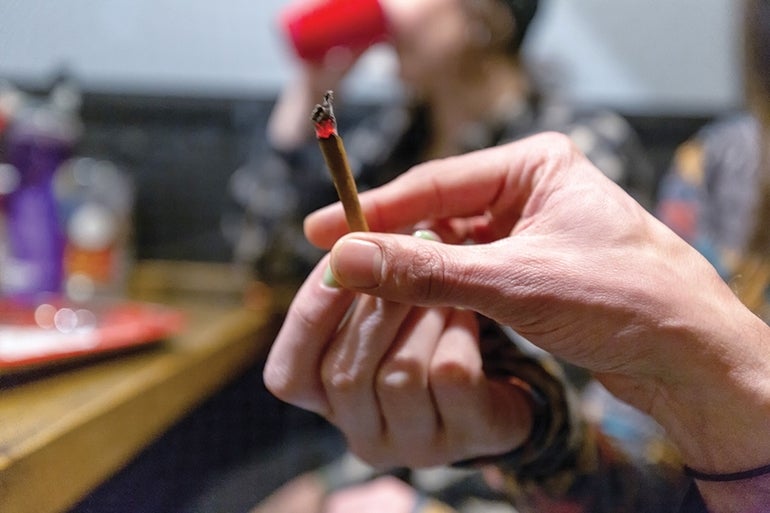Cannabis is now legal to buy, but we still don't know what to expect
 Photo/Elizabeth Brooks
People can now buy cannabis legally in Central Massachusetts. In other states where sales have been legal for years, health research has been largely inconclusive on whether the new market is harmful or beneficial.
Photo/Elizabeth Brooks
People can now buy cannabis legally in Central Massachusetts. In other states where sales have been legal for years, health research has been largely inconclusive on whether the new market is harmful or beneficial.
For the past decade, when Massachusetts was considering legalizing marijuana for any adult to use, medical groups warned against the new industry opening up access for youth or acting as a gateway toward more serious drugs.
Others extolled the health benefits. After all, Massachusetts voters approved marijuana for medicinal use in 2012, before recreational was on the table.
Now with shops legally selling marijuana products in Central Massachusetts – Cultivate opened in November in Leicester, and Good Chemistry will open in April in Worcester – doctors and researchers are readying to find out if the effects they foresaw will come true.
Thanks to unresolved research, no one is quite sure what to expect.
Studies in more mature legal marijuana markets have found some health changes but none officials in those states have deemed concrete evidence of changed habits or harms.
Regardless, the new marijuana market appears unlikely to settle debates over the drug’s benefits and harms.
“The jury is definitely still out,” said Dr. Mark Neavyn of UMass Medical School in Worcester, who specializes in emergency medicine and toxicology.
“People spend a lifetime trying to figure that out,” Neavyn said. “I don’t think we’ll see any concrete evidence either way any time soon.”
Unsettled science
If there’s one thing changed with marijuana over the years, it’s been public perception about the drug.
A Pew Research Center poll released last October found 62 percent of Americans say marijuana should be legalized. That’s up from just 32 percent in a Pew poll from 2010 and 16 percent in 1990.
Each successive generation has been more accepting, with 74 percent of Millennials saying the drug should be legal, Pew found.
Even as acceptance has spread, experts aren’t any closer to agreement on whether marijuana’s benefits outweigh its risks.
“Based on what I’ve looked at, there is a potential health benefit” to marijuana, Neavyn said. “But at the same time, we have to recognize that with any psychoactive element, it can potentially be harmful to people.”
Dr. Katherine Fitzgerald, a primary care physician at Heywood Hospital in Gardner who specializes in addiction, is more cautious. She’s found in her addiction clinic that cannabis can cause addiction to pot itself – a less-discussed effect than the potential role some doctors see as a gateway to use of more serious drugs.
“They cannot and will not go without it,” Fitzgerald said of addicted users.
Fitzgerald is a bit more optimistic on whether legal marijuana could lead to harder drug use. Users might pick up more dangerous habits if a marijuana drug dealer carries other drugs, or laces marijuana with narcotics. That’s not a risk at a licensed pot shop, she said.
Inconclusive findings
The medical community is split on the benefits and harms of marijuana, with studies sometimes showing correlation, if not necessarily causation.
Even the U.S. Centers for Disease Control & Prevention, a reliable go-to for the health industry, is somewhat unsure, if largely cautious.
The CDC says marijuana can be helpful in treating side effects of chemotherapy, but warns not enough evidence warrants recommending patients use it as a treatment. The same goes for treating chronic pain.
Likewise, the CDC says, researchers haven’t definitively linked marijuana to heavier drug use – a gateway drug, as critics call it. Though research has shown marijuana users to be more likely to use so-called harder drugs, there isn’t a proven cause-and-effect.
The National Institutes of Health is similarly ambivalent. Alcohol and nicotine users have higher rates of other drug use too.
“Whether smoking or otherwise consuming marijuana has therapeutic benefits that outweigh its health risks is still an open question that science has not resolved,” says Dr. Nora Volkow, the director of the National Institute on Drug Abuse.
The Massachusetts Cannabis Control Commission, which reviews applications from prospective pot growers and sellers, is keeping a close eye too, said Jennifer Flanagan of Leominster, a commissioner placed on the board by Gov. Charlie Baker as a public health appointee.
Flanagan’s role on the commission is noteworthy as someone who had said she didn’t think the 2016 ballot question calling for legal adult use was a good idea. Flanagan, a former state representative for the Leominster area, said she still worries about youth using marijuana now with it available for legal purchase by those over 21.
Flanagan said she doesn’t like the term “recreational use” for the new marijuana law, in contrast to the earlier state law, which passed in 2012 establishing medicinal-use shops.
“It is an adult product, which is why we call it adult use,” she said.
State remains active
The Cannabis Control Commission is still working to educate residents in the first state on the East Coast to open pot shops, which opened their doors last November.
CCC has set up a website with short answers to common questions about effects on lung health, mental health or addiction. It has created brochures and videos urging responsible use for adults and youth prevention. Residents should expect to see billboard ads soon, too, Flanagan said.
The commission – which is expected to move its headquarters to Worcester’s Union Station later this year – will monitor health research on marijuana use and its effects in a detailed way Flanagan said hasn’t been done in Massachusetts before.
“We don’t have a lot of the data because we’ve never had to collect the data before,” she said.
The state legislature’s Joint Committee on Marijuana Policy is taking up bills to lead to further change.
In just the short period since the legislative session started in January, the committee has already been tasked with reviewing a series of bills including one to devote 1 percent of the recreational marijuana excise tax to youth substance use prevention.
Colorado, Oregon, Washington results
Researchers have been busy monitoring potential effects in the first states to open legal pot shops, tracking everything from crime rates to accident rates. So far, tests and studies don’t appear to show definitive harms in the eyes of public health officials.
In Colorado, the nation’s first state to open recreational marijuana stores, the first legal pot shops opened in 2014. That’s given a long head start toward monitoring health effects.
A 2018 report from Colorado’s Department of Public Health & Environment found significant increases in marijuana use among adults in the previous year. Marijuana use among adolescents was stable since 2005, and no changes were found in the rate of those who reported driving a vehicle within a few hours of using marijuana since the year pot shops opened.
Tobacco use among adults fell slightly, and use among high school students remained consistent with national averages, the state found. More troubling, rates of women using marijuana while pregnant or breastfeeding rose, as did marijuana use inside homes with children.
But the state warned available data couldn’t answer questions about whether use patterns changed as a result of legalization, or whether they would continue in coming years.
Dr. Andrew Monte at the University of Colorado School of Medicine found emergency room visits for cannabis edibles have been 30 times higher than what would be expected if edibles were equally as toxic as inhaled cannabis.
Last fall, a Colorado man blamed edibles for his mental state when he allegedly murdered his wife. In 2014, a man jumped off a roof to his death after eating a cookie baked with marijuana.
Those findings could lead to more discussion about whether edibles should be banned from retail environments, said Monte, a UMass Medical School graduate.
Colorado State University psychology professors Brad Conner and Mark Prince have found high rates of out-of-state users traveling to get a legal high, and significant but temporary rates of reported first-time users.
In Oregon, state reporting has shown increases in marijuana use among all age ranges, including those under 21, who aren’t able to buy legally there. In 2016, a year after the first stores opened, one in six adults reported using marijuana in the past 30 days. Marijuana-related visits to emergency rooms doubled in a two-year period following the first shops opening.
Elsewhere, the Washington State Institute for Public Policy is required by state law to study how the state’s legalization affects public health and safety, cannabis use, the criminal justice system and other factors. The first pot shops opened in Washington just months after Colorado in 2014.
The institute’s most recent report in 2017 found no effect from legalization on cannabis abuse treatment admissions. Youth didn’t report significantly easier time getting marijuana, and those who said they’ve used it actually fell. Binge drinking and cigarette smoking also fell slightly.
Some of those results surprised Adam Darnell, a senior research associate at the Washington State Institute for Public Policy. Most were expecting youth marijuana use to increase, and marijuana convictions for those under 21, which fell considerably, caught observers off guard, he said.
With so little marijuana research until now — federal funds for studies remain impossible — experts are looking forward to finding out more about cannabis’ effects than ever before.
“Research is really far behind, but we’re starting to catch up,” Conner said. “We’re starting to have a lot more opportunity for research, and in that way, the effects of legalization are quite positive.”









0 Comments